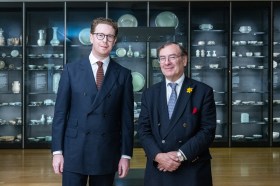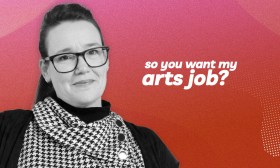Viktor is the star of the new show at the ICA. Like his older brother Hektor, he likes to draw lines, patterns, words on the wall, but he only works in the medium of chalk. Like a diminutive Frankenstein for the computer age, he was assembled in a Zurich basement, the fruit of many feverish long hours of trial and error, by the young and wonderfully geeky artist/designer/programmer, Jurg Lehni. Viktor, strung up on the wall between four motors as in some obscure Mongolian torture, whirs his way around the giant blackboard, leaving geometric trails of chalk behind him. He is the bastard son of a series of computer programs, hijacked by Lehni, and as such, forms the centre piece of an exhibition which attempts to dissolve “the blunt duality of man vs. machine”, in the words of curator Emily King.
King relates the genesis of Viktor as an epic series of breakthroughs and creative doldrums, a prose which sits rather oddly with the small, buzzing machine. Indeed, those unfamiliar with computer code and all its arcane intricacies may find Viktor rather bemusing. Nevertheless, Lehni shows how far too often we see the machine as a given; he suggests that we can interfere, rearrange, and ultimately, express ourselves with the various softwares that we are sold. As real as the chalk it scrapes behind it, Viktor leaps from the computer screen to show how the virtual tools of writing and drawing – the programs – can be just as malleable, and just as plastic, as a pencil.
Lehni’s collaborator in the show is Alex Rich, a British designer with a nuanced touch for the imbrications of man and man-made. Dots on Demand allows the lucky gallery goer to compose a short phrase on a monitor, which is then made into a poster by a frenetic hole-punching machine. It even punches two holes at the top, to hang the sheet from the gallery wall. News on Demand involves three hand-held printers used in factories for labelling boxes. Grasping it like a pen, the user strokes it across his gallery notes to see a topical phrase appear in ink, ‘PAIR HELD IN BOTCHED GAS SUICIDE’, ‘FISHERMEN STAGE SIT-IN’. The words can appear backwards, stretched out, illegible or just as a black smudge, according to the movement of the user’s hand. These are engaging games: half ‘hands-on’ Science Museum, half worthy philosophical concept.
Observing these strange technological toys sit three television screens in the centre of the gallery. Warped monochrome lines creep, Tetrus-like, across their faces, forming basic, jumbled patterns whose ‘accidental beauty’ may be accessible to the computer technician alone. Yet, like Viktor, they reveal the hidden processes behind our ever-more impatient double click, and re/up/down load. This is a curious show, the more playful aspects of which are not encouraged by the drably coloured walls, and the grip of ICA jargon which extends from the gallery notes. It will perhaps come into its own, though, as it sees collaborative events featuring, amongst others, the ubiquitous Ryan Gander, and a Finnish architect on his glass harp, accompanying the movements of Viktor.
A Recent History of Writing and Drawing
ICA, 9 July – 31 August 2008




